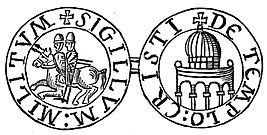Knights Templar
| Knights Templar Poor Fellow-Soldiers of Christ and of the Temple of Solomon Pauperes commilitones Christi Templique Salomonici Hierosolymitanis |
|
|---|---|

|
|
| Active | c. 1119–1312 |
| Allegiance | The Pope |
| Type | Catholic military order |
| Role | Protection of Christian Pilgrims |
| Size | 15,000–20,000 members at peak, 10% of whom were knights |
| Headquarters |
Temple Mount, Jerusalem, Kingdom of Jerusalem |
| Nickname(s) |
Order of Solomon's Temple Order Of Christ |
| Patron | Saint Bernard of Clairvaux |
| Motto(s) |
Non nobis, Domine, non nobis, sed Nomini tuo da gloriam (English: Not unto us, O Lord, not unto us, but unto thy Name give glory) |
| Attire | White mantle with a red cross |
| Mascot(s) | Two knights riding a single horse |
| Engagements |
The Crusades, including: |
| Commanders | |
| First Grand Master | Hugues de Payns |
| Last Grand Master | Jacques de Molay |
The Crusades, including:
The Poor Fellow-Soldiers of Christ and of the Temple of Solomon (Latin: Pauperes commilitones Christi Templique Salomonici), also known as the Order of Solomon's Temple (French: Ordre du Temple or Templiers, Arabic: فرسان الهيكل), the Knights Templar, or simply as Templars, was a Catholic military order recognised in 1139 by papal bull Omne Datum Optimum of the Holy See. The order was founded in 1119 and active from about 1129 to 1312.
The order, which was among the wealthiest and most powerful, became a favoured charity throughout Christendom and grew rapidly in membership and power. They were prominent in Christian finance. Templar knights, in their distinctive white mantles with a red cross, were among the most skilled fighting units of the Crusades. Non-combatant members of the order managed a large economic infrastructure throughout Christendom, developing innovative financial techniques that were an early form of banking, and building fortifications across Europe and the Holy Land.
The Templars were closely tied to the Crusades; when the Holy Land was lost, support for the order faded. Rumours about the Templars' secret initiation ceremony created distrust, and King Philip IV of France – deeply in debt to the order – took advantage of the situation to gain control over them. In 1307, he had many of the order's members in France arrested, tortured into giving false confessions, and burned at the stake.Pope Clement V disbanded the order in 1312 under pressure from King Philip.
...
Wikipedia
